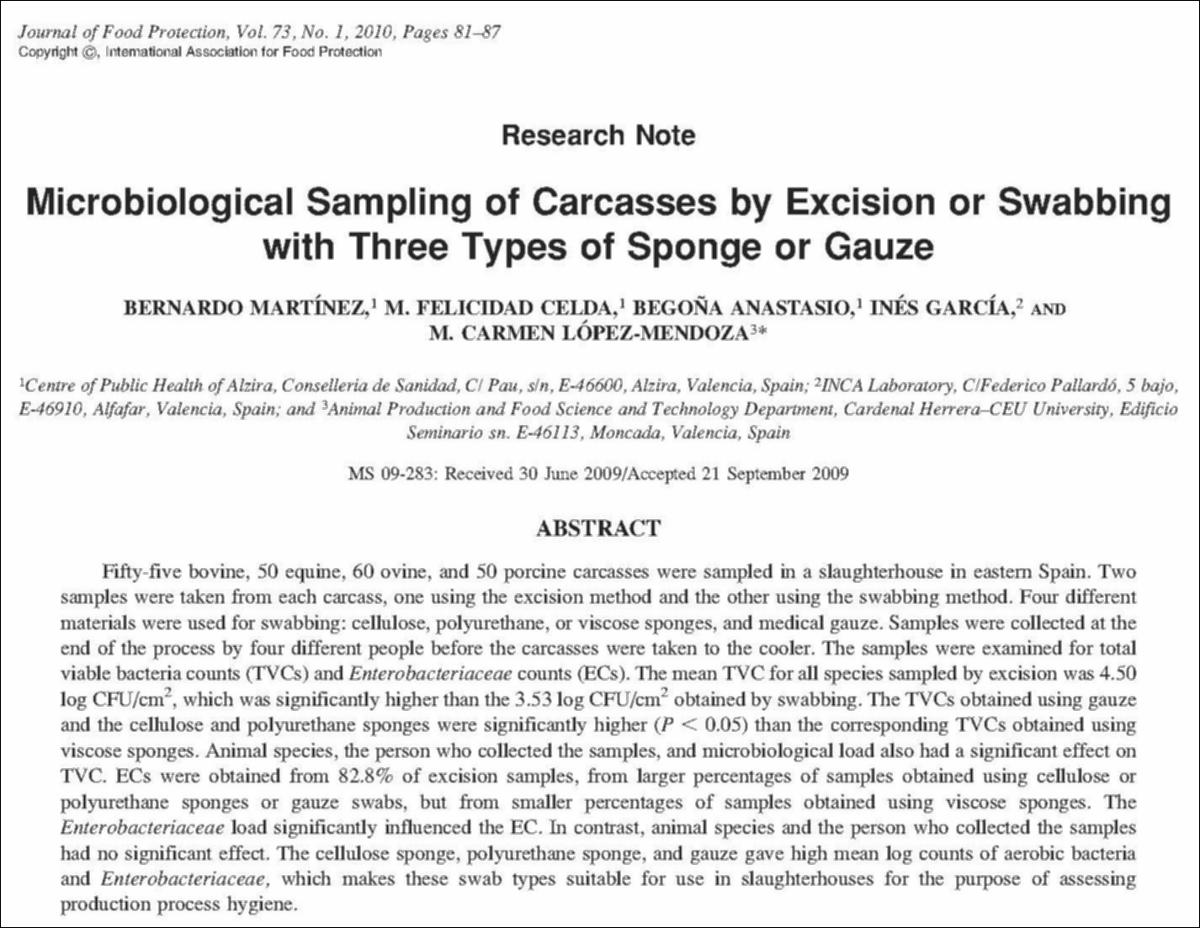Please use this identifier to cite or link to this item:
http://hdl.handle.net/10637/16291Microbiological sampling of carcasses by excision or swabbing with three types of sponge or gauze

See/Open:
Microbiological_Martinez_JOFP_2010.jpg
452,8 kB
JPEG
See/Open:
Microbiological_Martinez_JOFP_2010.pdf
Restricted Access
167,99 kB
Adobe PDF
Request a copy
| Title: | Microbiological sampling of carcasses by excision or swabbing with three types of sponge or gauze |
| Authors : | Martínez, Bernardo Celda, M. Felicidad Anastasio, Begoña García, Inés López Mendoza, María Carmen |
| Keywords: | Microbiología; Microbiology; Industria cárnica; Meat processing industry; Seguridad de los alimentos; Food safety; España; Spain; Ganado; Livestock |
| Publisher: | Elsevier International Association for Food Protection |
| Citation: | Martínez, B., Celda, M.F., Anastasio, B., García, I., & López-Mendoza, M.C. (2010). Microbiological sampling of carcasses by excision or swabbing with three types of sponge or gauze. Journal of Food Protection, 73(1), 81–87. https://doi.org/10.4315/0362-028x-73.1.81 |
| Abstract: | Fifty-five bovine, 50 equine, 60 ovine, and 50 porcine carcasses were sampled in a slaughterhouse in eastern Spain. Two samples were taken from each carcass, one using the excision method and the other using the swabbing method. Four different materials were used for swabbing: cellulose, polyurethane, or viscose sponges, and medical gauze. Samples were collected at the end of the process by four different people before the carcasses were taken to the cooler. The samples were examined for total viable bacteria counts (TVCs) and Enterobacteriaceae counts (ECs). The mean TVC for all species sampled by excision was 4.50 log CFU/cm(2), which was significantly higher than the 3.53 log CFU/cm(2) obtained by swabbing. The TVCs obtained using gauze and the cellulose and polyurethane sponges were significantly higher (P < 0.05) than the corresponding TVCs obtained using viscose sponges. Animal species, the person who collected the samples, and microbiological load also had a significant effect on TVC. ECs were obtained from 82.8% of excision samples, from larger percentages of samples obtained using cellulose or polyurethane sponges or gauze swabs, but from smaller percentages of samples obtained using viscose sponges. The Enterobacteriaceae load significantly influenced the EC. In contrast, animal species and the person who collected the samples had no significant effect. The cellulose sponge, polyurethane sponge, and gauze gave high mean log counts of aerobic bacteria and Enterobacteriaceae, which makes these swab types suitable for use in slaughterhouses for the purpose of assessing production process hygiene. |
| Description: | Este recurso no está disponible en acceso abierto por política de la editorial. |
| URI: | http://hdl.handle.net/10637/16291 |
| Rights : | http://creativecommons.org/licenses/by-nc-nd/4.0/deed.es Open Access |
| ISSN: | 0362-028X 1944-9097 (Electrónico) |
| Issue Date: | Jan-2010 |
| Center : | Universidad Cardenal Herrera-CEU |
| Appears in Collections: | Dpto. Producción y Sanidad Animal, Salud Pública Veterinaria y Ciencia y Tecnología de los Alimentos |
Items in DSpace are protected by copyright, with all rights reserved, unless otherwise indicated.

